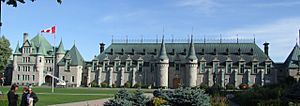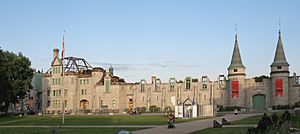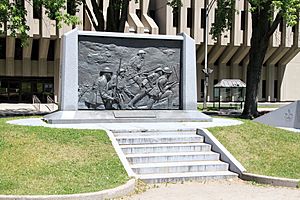Quebec City Armoury facts for kids
Quick facts for kids Grande Allée Drill Hall, Voltigeurs de Québec Armoury |
|
|---|---|
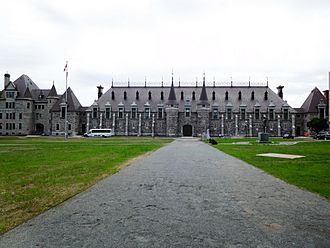
The Armoury in 2018, after its reconstruction
|
|
| General information | |
| Type | Drill Hall / armoury |
| Architectural style | Gothic Revival Chateau-style |
| Address | 805, avenue Wilfrid-Laurier Quebec City, Quebec G1R 2L3 |
| Construction started | 1885 |
| Completed | 1888 |
| Renovated | 2018 (rebuilt) |
| Destroyed | 2008 (fire) |
| Owner | Canadian Forces |
| Design and construction | |
| Architect | Eugène-Étienne Taché |
| Awards and prizes | National Historic Site; national Register of Historic Places; Classified - 1987 Register of the Government of Canada Heritage Buildings |
The Voltigeurs de Québec Armoury is a historic building in Quebec City, Canada. It was also known as the Grande-Allée Armoury. It was built between 1885 and 1888. The building was designed by a famous architect named Eugène-Étienne Taché. It's a special place called a National Historic Site.
The armoury was built as a 'drill hall' for an army group called Les Voltigeurs de Québec. A drill hall is a large building where soldiers train and practice. The building has a unique Gothic Revival style, like an old castle.
Sadly, a big fire damaged the armoury in 2008. But it was rebuilt and opened again in May 2018.
Contents
A Look Back: The Armoury's Story
In the Canadian Forces, an armoury is a place where reserve soldiers train. They meet there, practice drills, and hold parades.
The Big Fire of 2008
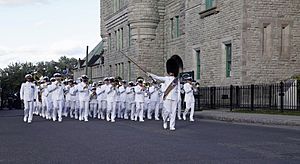
On April 4, 2008, the Voltigeurs de Québec Armoury was badly damaged by a fire. Most of the building burned down. Only a back wall and the towers by the front door were left.
The fire also destroyed the Les Voltigeurs de Québec Museum inside. This museum held many important items from the regiment's history. Luckily, about 90 percent of these items were saved. This was thanks to the quick actions of the soldiers and local firefighters.
The armoury was supposed to be a main spot for Quebec's 400th birthday celebrations that year. The building's wooden roof was one of the biggest of its kind in Canada.
Rebuilding the Armoury
After the fire, many people wanted the armoury to be rebuilt. The Canadian government quickly agreed. In April 2008, they set aside $2 million to plan the reconstruction.
Work to rebuild the armoury finished by the spring of 2018. The building then reopened. It is now used by the public, the military, and other government offices.
A Special Sculpture: "JE ME SOUVIENS"
In front of the armoury, there is a large sculpture called "JE ME SOUVIENS." This means "I REMEMBER" in French. It was created in 1989 by André Gauthier.
This sculpture is a memorial made of bronze and granite. It honors soldiers from the Royal 22e Régiment. This French-Canadian army group is also known as the Van Doos. The sculpture remembers soldiers who died in the First and Second World Wars, and the Korean War.
The sculpture was inspired by a painting called "L'Avance." This painting is at the Canadian War Museum. The names of the brave soldiers are carved into the granite of the monument.
Recognizing History: The Plaque
In 1991, a special plaque was put up at the armoury. It was placed by the Historic Sites and Monuments Board of Canada. This plaque celebrates the Grande Allée Drill Hall and its unique design.
The plaque says that the drill hall is an amazing example of its kind. It still has its original parade square. The building was designed by Eugène-Étienne Taché and finished in 1887. A part was added in 1913.
The armoury has a steep roof, cone-shaped towers, and fancy decorations. These features make it an early example of the French-inspired Château style. Using this style for a drill hall was very unusual in Canada at that time. It shows how people in the late 1800s were interested in Quebec City's French history.
Images for kids
-
The Band of the Royal Canadian Mounted Police playing in Quebec City



